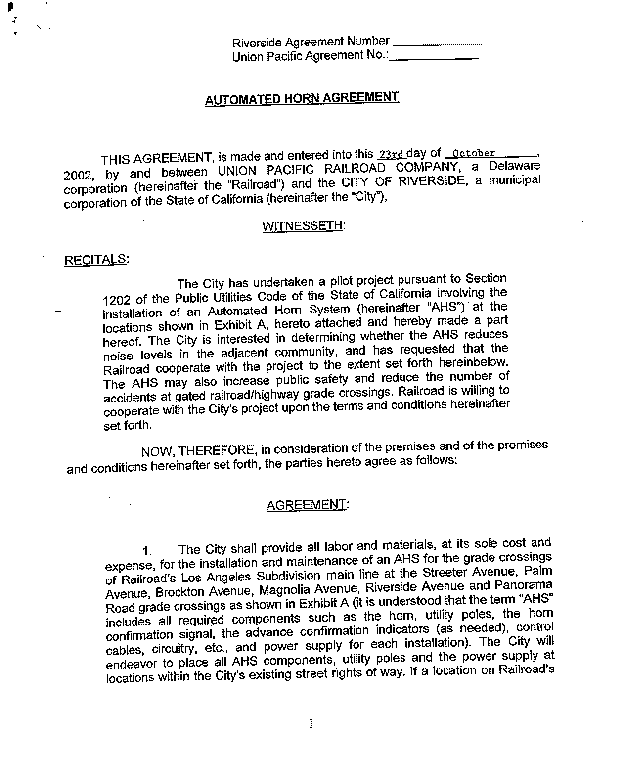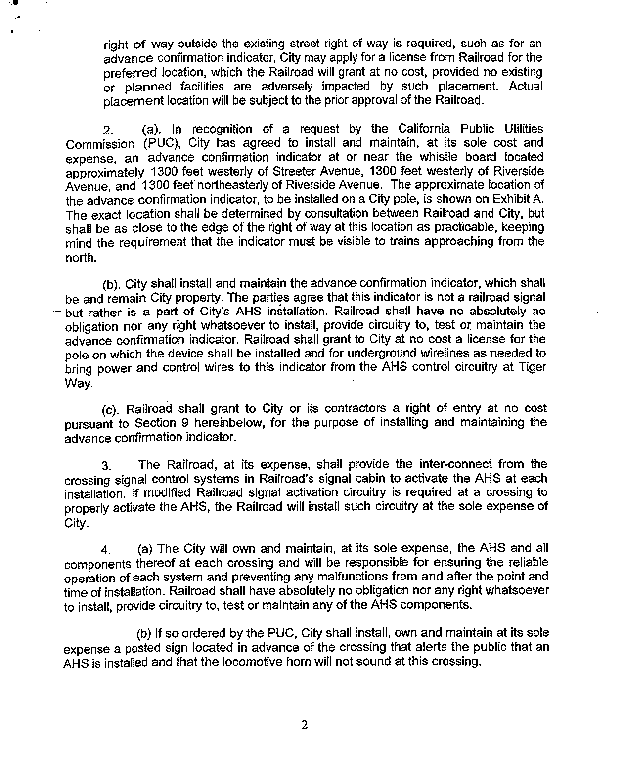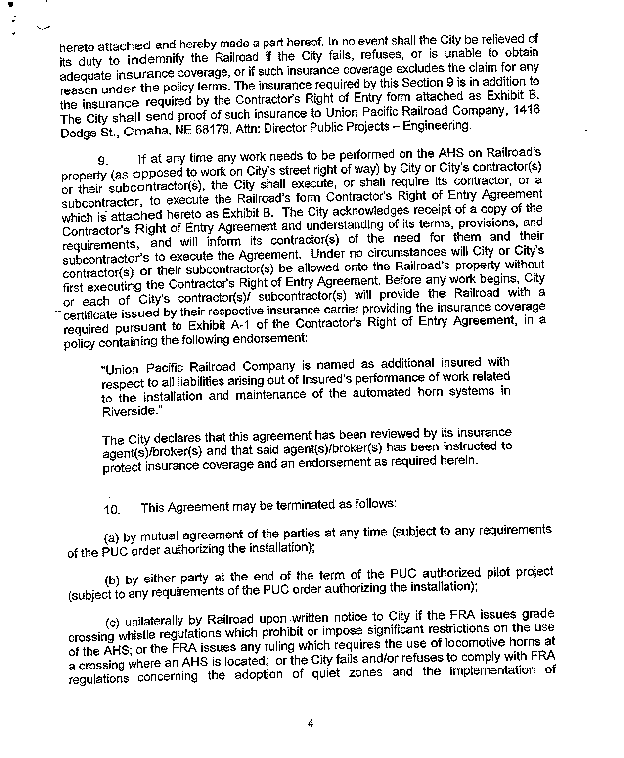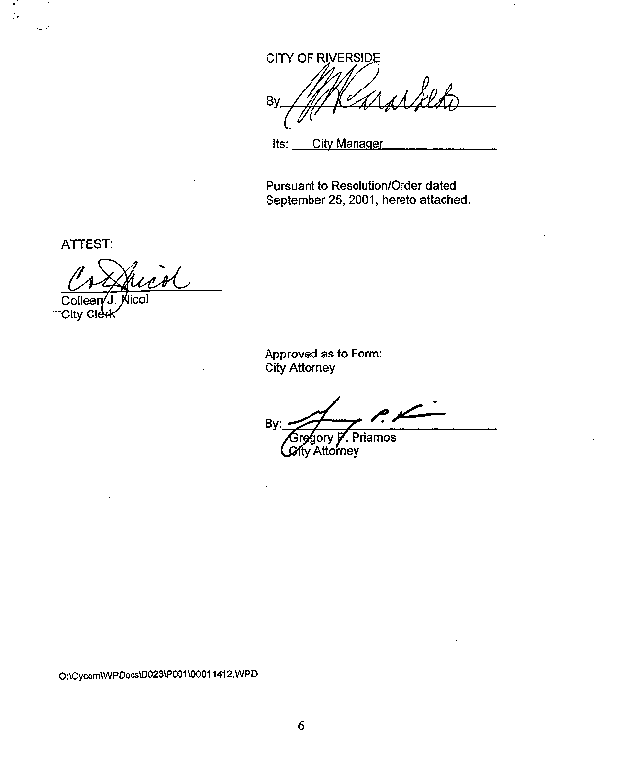I. Background
The City of Riverside in conjunction with the Federal Railroad Administration (FRA) and California Public Utilities (PUC) will perform a six (6) month monitoring program of the Automated Horn System (AHS) proposed for installation at the Streeter Avenue, Palm Avenue, Brockton Avenue, Magnolia Avenue, Riverside Avenue and Panorama Road at grade crossings. The purpose of the monitoring is to evaluate the effectiveness of the (AHS) as a supplementary safety measure by the FRA and PUC as part of the Final Rule for Use of Locomotive Horns at Highway Rail Grade Crossings. The program will monitor effectiveness of the AHS in Roseville through collection of driver behavior data, train operator acceptance, and acceptance by adjacent residences and businesses.
II. Monitoring Program
The following tasks constitute the City of Riverside AHS monitoring program:
Task 1 - Video Monitoring Driver Behavior Prior to Activation of AHS
The video monitoring program will measure for three (3) months the effect of the train-mounted horn and existing gate and signal warning devices on driver behavior.
Task 1.1 Equipment
A video camera will be mounted on a pole at each of the six (6) at grade crossings to record driver behavior. Each camera should be mounted on the same utility pole as the wayside horn, but at a higher elevation. In each case, the video camera must capture driver behavior on both sides of the road between the gates on either side of the track(s). The video camera shall feed into some recording system or computer system located at the crossing. The system shall be located in a protected environment at the grade crossing. The track circuitry responsible for activating the gates and flashing lights also should activate a timer that starts the video/computer equipment to begin recording. The video equipment activated by the timer records the scene for duration of 60 seconds after train arrival at the crossing.
Task 1.2 Performance Measures And Data Collection
Two performance measures, number of aggressive driving behaviors and number of violations will be used to compare the existing warning system to one supplemented by the AHS. Aggressive driving behavior is defined as driving through the grade crossing while the gates are in the process of descending, but not yet completely descended. A violation is defined as a vehicle driving around the gates after they have descended. The more important of the two measures is the number of violations.
Data will be collected for three (3) months, using video cameras to capture driver behavior. The data will be collected for a period of 60 seconds following activation of the grade crossing signal.
1.
The purpose of video analysis is to determine if the wayside horn provides warning comparable to existing train-mounted horns. To make this determination a comparison of the number of violations recorded during operation of the two warning systems will be made. For both warning systems answers to the following questions shall be documented:
1. How many events were observed? (An event is defined as the crossing gate descending from the upright position and results in a train crossing the tracks before the gates return to their upright position).
2. How many trains were observed?
Task 1.3 Aggressive Driving Analysis
How does the aggressive driving rate vary for the two types of auditory warnings?
Task 1.4 Driver Violation Analysis
What is the violation rate?
How does the violation rate vary for the two types of auditory warnings?
In addition to the above research questions, a summary of the data needed to conduct an analysis is as follows:
# of events
# of trains passing through the grade crossing
# of motor vehicles passing through grade crossing
(Average Daily Vehicle count to be performed at beginning of the monitoring period and at end of the monitoring period)
# of aggressive driving events
# of violations
Task 2 - Video Monitoring Driver Behavior During Use of AHS
The video monitoring program will measure for three (3) months the effect of the AHS on driver behavior.
Task 2.1 Equipment
The same video equipment installed for Task 1 will be used for Task 2.
Task 2.2 Data Collection
The same performance measures used for Task 1 will be used for Task 2
The follow data will be collected
1. # of train and vehicle exposure events
2. # of trains passing through the grade crossing
3. # of motor vehicles passing through grade crossing
4. Duration of data recording equipment failure (i.e. data logger collecting data on track circuit activation and video recording equipment collecting driver behavior data).
Task 2.3 Data Recording Sheet
A data-recording sheet will be used to code information collected from videotape footage. The following information will be collected:
Type of Information Format
1. Tape # Number
2. Date Month/Day/Year
3. Event Start Time Military Time
4. Event # Number
5. Train arrived at crossing Yes/No
6. # of aggressive driving events Number
7. # of violations Number
8. Miscellaneous observations of driver behavior Text
Task 3 - Additional Surveys of Locomotive Engineers, Conductors and Adjacent Residents/Businesses
Three (3) surveys, will be conducted quarterly of locomotive engineers, conductors and residents/businesses adjacent to the Streeter Avenue, Palm Avenue, Brockton Avenue, Magnolia Avenue, Riverside Avenue and Panorama Road crossings at-grade crossings to identify their perceptions of AHS operations and effectiveness.
Task 3.1 Survey of Locomotive Engineers & Conductors
Within 60 days of AHS activation a survey of locomotive engineers and conductors will be conducted to identify their perceptions of the AHS. The survey will be performed three times on a quarterly basis, upon activation of the AHS. The survey will include the following questions:
1. Have the locomotive engineers observed changes in motorist behavior at the crossing since the AHS has replaced locomotive-based horns?
2. Is the confirmation signal an effective mechanism confirming AHS operation?
3. Have the locomotive engineers had to use the locomotive horn at the Yosemite and Tahoe crossings since activation of the AHS?
a. Describe factors, which lead to use of locomotive horn.
Task 3.2 Survey of Residents and Businesses
Within 60 days of AHS activation a survey of residents and businesses adjacent to Streeter Avenue, Palm Avenue, Brockton Avenue, Magnolia Avenue, Riverside Avenue and Panorama Road crossings will be surveyed to identify their perception of the AHS. The survey will be performed three times on a quarterly basis, upon activation of the AHS. The survey will include the following questions:
2. Have the residents and businesses observed changes in motorist behavior at the crossing since AHS has replaced locomotive-based horns?
3. Have the residents and businesses observed the use of locomotive-based horns since activation of the AHS?
Task 3.3 Survey of Accident History
During the twelve (12) month monitoring program an accident history for the Yosemite and Tahoe at-grade-crossings will be maintained.
Task 4 - Final Report
The final report will review the monitoring results. The results will be provided to the FRA, PUC, Union Pacific, AHS manufacturers, and employee unions.








